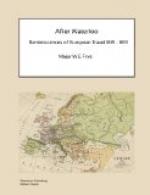I must not omit to mention that there is a breed of camels here belonging to the Grand Duke; I believe it is the only part of Europe except Turkey where the breed of camels is attempted to be propagated.
LEGHORN, 17 Novr.
I left Pisa for Leghorn on the morning of the 15th November, and after a drive of two hours in a cabriolet I arrived at the latter place and put up at the Aquila Nera. The distance between Pisa and Leghorn is only 10 or 11 miles and a plain with few trees, either planted in corn or in pasturage, forms the landscape between the two cities.
Leghorn (Livorno), being a modern city, does not offer anything remarkably interesting to the classical traveller either from its locality or its history. Founded under the auspices of the Medici it has risen rapidly to grandeur and opulence, and has eclipsed Genoa in commerce. It is a remarkably handsome city, the streets being all broad and at right angles; the Piazze are large and the Piazza Grande in particular is magnificent. There is a fine broad street leading from the Piazza Grande to the Port. The Port and Mole are striking objects and considerable commercial bustle prevails there.
Among the few things worthy of particular notice is the Jewish Synagogue, decorated with costly lamps and inscriptions in gold in the Hebrew and Spanish languages, many of which allude to the hospitality and protection afforded to the Hebrew nation by the Sovereigns of Tuscany. There are a great number of Hebrew families here: they all speak Spanish, being the descendants of those unfortunate Jews who were expelled from Spain at the time of the expulsion of the Moors in the reign of Don Felipe III surnamed el Discreto, who was determined not to suffer either a Jew, Mahometan or heretic in all his dominions. This barbarous decree was the ruin and destruction of a number of industrious families, thousands of whom died of despair at being exiled from their native land. In return for this what has Spain gained? The Inquisition—despotism in its worst form—poverty—rags —lice—an overbearing insolent and sanguinary priesthood of whom the monarch is either the puppet or the slave; a degraded nobility; a half savage, grossly ignorant, lazy and brutal people. A proper judgment on the Spanish nation for its cruelty and fanaticism! My guide at Leghorn conducted me to see the burying ground belonging to the English factory, which is interesting enough from the variety of tombs, monuments and inscriptions. Here all Protestants, to whatever nation they belong, are buried. I noticed Smollett’s tomb. It is on the whole an interesting spot, tho’ not quite so much so as the cemetery of Pere La Chaise at Paris.
I returned to Florence from Leghorn tout d’une traite in the diligence. We stopped at Fornacetti (half way) to dine. There is a good table d’Hote (ordinario) there.
FLORENCE, 22nd Novr.




